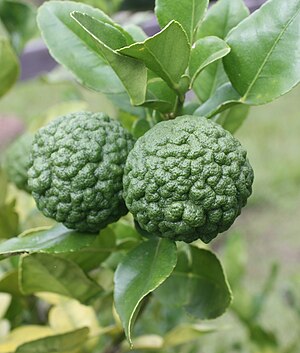Kaffir lime/ja: Difference between revisions
Created page with "{{Speciesbox |image = Citrus hystrix fruit.jpg |image_caption = 木の上の果物 |range_map = Map of inferred original wild ranges of the main Citrus cultivars, and selected relevant wild taxa (Fuller et al., 2017).png |range_map_caption = 主要な柑橘類栽培品種の推定される原生地の地図(''C. hystrix''は薄緑色で示す) |genus = Citrus |species = hystrix |authority = DC. |synonyms = {{Plainlist | style..." |
Created page with "マクルートライムの果皮には、ライムの果皮油に匹敵するエッセンシャルオイルが含まれており、その主な成分はリモネンとβ-ピネンである。" |
||
| (24 intermediate revisions by the same user not shown) | |||
| Line 36: | Line 36: | ||
}} | }} | ||
'''''Citrus hystrix'''''は、'''コブミカン'''、'''タイライム'''、または'''マクルートライム'''と呼ばれ、[[:en:tropical Asia|熱帯]][[:en:Southeast Asia|東南アジア]]原産の[[citrus fruit/ja|柑橘類]]の果物である。 | |||
'''''Citrus hystrix''''' | |||
その果実と葉は[[Southeast Asian cuisine/ja|東南アジア料理]]で、[[:en:Petitgrain|エッセンシャルオイル]]は香水製造で使用される。その皮と砕いた葉は、強い柑橘系の香りを放つ。 | |||
==名称{{Anchor|Names}}== | |||
==Names== | [[File:Citrus hystrix Blanco2.408-cropped.jpg|thumb|left|upright|[[:en:Francisco Manuel Blanco|フランシスコ・マヌエル・ブランコ]]による''C. hystrix''のイラスト]] | ||
[[File:Citrus hystrix Blanco2.408-cropped.jpg|thumb|left|upright| | |||
最も可能性の高い[[:en:etymology|語源]]は、[[:en:Sri Lanka Kaffirs|カフィア族]]を経由するものである。彼らは[[:en:Sri Lanka|スリランカ]]の民族集団で、一部は奴隷化された[[:en:Bantu peoples|バンツー族]]の子孫である。最も古い既知の言及は、1888年の[[:en:Emanuel Bonavia|エマヌエル・ボナヴィア]]による『''The Cultivated Oranges, Lemons Etc. of India and Ceylon''』という本に、「caffre」という別の綴りで記されている。「プランテーションの[[:en:coolie|クーリー]]たちは、ヒルを避けるために足や脚にこれを塗る。そのためセイロン[スリランカ]では、''Kudalu dchi''、つまりヒルライムという名前も付けられている。ヨーロッパ人はそれをカフィアライムと呼ぶ」。同様に、H.F.マクミランの1910年の著書『''A Handbook of Tropical Gardening and Planting''』には、「セイロンの『カフィアライム』」と記されている。 | |||
別の語源としては、インドのイスラム教徒が東方の非イスラム圏から輸入した果物に、直接「異質性や異国情緒」を伝えるために名付けたという説がある。この果物の名前が、[[:en:South Africa|南アフリカ]]の民族的蔑称である「[[:en:Kaffir (racial term)|カフィア]]」(''下記「南アフリカ」参照'')に直接由来するという主張は、十分に裏付けられていない。 | |||
''C. hystrix''は、その原産地で様々な名前で知られている: | |||
''C. hystrix'' | |||
* [[:en:Javanese language|ジャワ語]]では{{lang|jv|jêruk purut}}、[[:en:Malay language|マレー語]]では{{lang|ms|limau purut}}(それぞれ[[:en:Indonesian language|インドネシア語]]と[[:en:Malaysian language|マレーシア語]]に導入されている)は、果実のでこぼこした質感から「いぼ状の/皮が粗いライム」を意味する。 | |||
* [[:en:Chinese language|中国語]]では{{transliteration|zh|jiàn yè chéng}}({{lang|zh|箭叶橙}}「矢の葉ライム」)。 | |||
* フィリピンでは{{lang|tl|kabuyaw}}または{{lang|tl|kulubot}}。[[:en:Laguna (province)|ラグナ州]]の[[:en:Cabuyao|カブヤオ]]市はこの果物にちなんで名付けられた。 | |||
* {{lang|tl|kabuyaw}} | * ''Kolumichai''、[[:en:Kongu Tamil|コングタミル語]]で<span lang="ta">கொலுமிச்சை</span> | ||
*''Kolumichai'' | * タイでは{{transliteration|th|makrud}}または{{transliteration|th|makrut}}({{lang|th|[[wikt:มะกรูด|มะกรูด]]}}、{{IPA|lang=th|/máʔ.krùːt/}})([[bergamot orange/ja|ベルガモットオレンジ]]にも使われる名前)。 | ||
* {{transliteration|th|makrud}} | * ラオスでは{{transliteration|lo|mak khi hut}}({{lang|lo|ໝາກຂີ້ຫູດ}}、{{IPA|lang=lo|/ma᷆ːk.kʰi᷆ː.hu᷆ːt/}})。 | ||
* {{transliteration|lo|mak khi hut}} | * [[:en:Vietnam|ベトナム]]では{{lang|vi|chúc}}または{{lang|vi|chanh Thái}}。 | ||
* {{lang|vi|chúc}} | * [[:en:Réunion|レユニオン]]島では{{lang|fr|combava}} | ||
[[Citrus micrantha/ja|ミクランサ]]は、フィリピン原産の同様の柑橘類で、[[Key lime/ja|キーライム]]や[[Persian lime/ja|ペルシャライム]]など、いくつかの雑種ライムの祖先であるが、''C. hystrix''のゲノム特性評価は、明確な結論を出すには不十分な詳細さでしか行われていないため、同一種であるかどうかは断定できない。 | |||
===南アフリカ=== | |||
== | 南アフリカでは、アラビア語の''kafir''が白人植民地主義者によって、黒人アフリカ人に対する民族的蔑称である「[[:en:Kaffir (racial term)|カフィア]]」として採用された。結果として、一部の著者は「カフィアライム」から、あまり知られていない「マクルートライム」への切り替えを推奨しており、南アフリカでは通常「タイライム」と呼ばれている。 | ||
==特徴{{anchor|Description}}== | |||
==Description== | ''C. hystrix''は、高さ{{convert|6|to|35|ft|0|disp=flip}}のとげのある低木または小高木で、芳香があり、[[leaf shape/ja|独特の形をした「二重」の葉]]を持つ。この砂時計型の葉は、葉身と平らな葉状の柄(植物学的には有翼の[[petiole (botany)/ja|葉柄]])から構成されている。果実はごつごつしていて緑色だが、熟すと黄色くなる。表面がでこぼこしていて、幅約{{convert|4|cm|0|abbr=on}}と小さいのが特徴である。果実は厚い皮([[Fruit_(plant_structure)/ja#Pericarp_layers|果皮]])を持ち、非常に酸味が強く、わずかに苦味がある。花は4枚から5枚の白い花弁を持ち、香りがよい。 | ||
''C. hystrix'' | |||
==歴史{{Anchor|History}}== | |||
==History== | [[:en:Pierre Sonnerat|ピエール・ソネラ]](1748年~1814年)は1771年~72年にその標本を採集し、ラマルクの『Encyclopédie Méthodique』(1796年)にも登場する。 | ||
[[Pierre Sonnerat]] | |||
マクルートライムは、1868年にセイロンで「カフィアライム」という名前で文献に登場する。そこでは、その汁を足や靴下に擦り込むことでヒルに噛まれるのを防ぐとされている。これがリーチライムという名前の由来である可能性がある。 | |||
==用途{{Anchor|Uses}}== | |||
==Uses== | ===料理=== | ||
=== | ''C. hystrix''の葉は、[[Indonesian cuisine/ja|インドネシア料理]]、[[Laotian cuisine/ja|ラオス料理]]、[[Cambodian cuisine/ja|カンボジア料理]]、[[Thai cuisine/ja|タイ料理]]などの東南アジア料理で使われている。この葉は、生、乾燥、冷凍のいずれかで、この植物の中で最も頻繁に使われる部分である。この葉は[[Thai cuisine|タイ料理]]([[tom yum/ja|トムヤム]]などの料理)や[[Cambodian cuisine/ja|カンボジア料理]](ベースペーストの「[[Kroeung/ja|クルアン]]」)で広く使われている。[[Vietnamese cuisine/ja|ベトナム料理]]では、鶏肉料理に香りを加えたり、カタツムリを蒸す際の強い臭いを抑えるために使われる。また、[[silkworms/ja|カイコ]]を養殖するベトナムの村では、[[pupa/ja|蛹]]の段階のカイコをコブミカンの葉と一緒に[[stir-fried/ja|炒める]]。この葉は[[Cuisine of Indonesia/ja|インドネシア料理]](特に[[Balinese cuisine/ja|バリ料理]]や[[Javanese cuisine/ja|ジャワ料理]])では[[soto ayam/ja|ソトアヤム]]などの食品に使われ、鶏肉や魚には[[Syzygium polyanthum/ja|インドネシアのベイリーフ]]と一緒に使われる。[[Cuisine of Malaysia/ja|マレーシア料理]]や[[Cuisine of Myanmar/ja|ビルマ料理]]でも見られる。 | ||
''C. hystrix'' | |||
[[Peel (fruit)/ja|果皮]](皮)は、ラオスや[[Thai curry/ja|タイカレー]]のペーストで一般的に使われ、芳香があり、渋みのある風味を加える。コババと呼ばれる果実の[[Zest (ingredient)/ja|ゼスト]]は、[[creole cuisine/ja|クレオール料理]]で[[:en:Mauritius/ja|モーリシャス]]、[[:en:Réunion|レユニオン]]、[[:en:Madagascar|マダガスカル]]の[[Flavored liquor/ja|インフューズドラム]]や[[rougails/ja|ルガイユ]]に風味を与えるために使われる。カンボジアでは、果実全体が[[candied fruit/ja|砂糖漬け]]にされる。 | |||
===薬用=== | |||
=== | 果皮の汁と皮は、一部のアジア諸国で伝統医学に使われている。果実の汁はシャンプーによく使われ、シラミを駆除すると信じられている。 | ||
===その他の用途=== | |||
== | この汁はタイや、時にはカンボジアで衣服や髪の洗浄剤として使われている。果実のスライスと混ぜた[[:en:Lustral water|清めの水]]は、カンボジアの宗教儀式で使われる。 | ||
マクルートライムオイルは、製薬、農業、食品、衛生、化粧品、香水産業など、多くの分野で原材料として使われている。また、アロマテラピーや様々な化粧品・美容製品の重要な成分としても広く使われている。 | |||
<gallery> | <gallery> | ||
File:Fish stuffed with Thai herbs.jpg|[[Channa striata| | File:Fish stuffed with Thai herbs.jpg|[[Channa striata/ja|ストライプドスネークヘッド]]に''C. hystrix''と[[Cymbopogon/ja|レモングラス]]を詰めて蒸す準備をしているところ | ||
File:Flickr - cyclonebill - Tom yam.jpg|''C. hystrix'' | File:Flickr - cyclonebill - Tom yam.jpg|[[tom yum/ja|トムヤム]]に浮かぶ''C. hystrix''の葉 | ||
File:Citrus hystrix DC. (AM AK305877-3).jpg| | File:Citrus hystrix DC. (AM AK305877-3).jpg|果実の縦断面 | ||
File:Combava Rind Madagascar.jpg| | File:Combava Rind Madagascar.jpg|乾燥させた果皮 | ||
File:Combava Powder Madagascar.jpg| | File:Combava Powder Madagascar.jpg|粉末にした果皮。[[Malagasy cuisine/ja|マダガスカル料理]]で使用 | ||
File:Phanaeng kai.jpg| | File:Phanaeng kai.jpg|鶏肉の[[phanaeng/ja|パネン]]に乗せられた葉の細切り | ||
File:2022.08-516-248ap1 Large bags with Citrus hystrix leaves for sale in Phou Puy Wholesale Vegetable Market in Battambang, Cambodia sat27aug2022-1516h.jpg|''C. hystrix'' | File:2022.08-516-248ap1 Large bags with Citrus hystrix leaves for sale in Phou Puy Wholesale Vegetable Market in Battambang, Cambodia sat27aug2022-1516h.jpg|[[:en:Battambang|バッタンバン]]のPhou Puy青果市場で販売されている''C. hystrix''の葉(2022年8月) | ||
</gallery> | </gallery> | ||
==栽培{{Anchor|Cultivation}}== | |||
==Cultivation== | [[File:Kaffir Lime (Citrus hystrix) 1.jpg|thumb|鉢植えの小さな''C. hystrix''の低木]] | ||
[[File:Kaffir Lime (Citrus hystrix) 1.jpg|thumb| | ''C. hystrix''は、家庭での果実生産のために、適切な気候の地域で庭園の低木として世界中で栽培されている。[[:en:container garden|コンテナガーデン]]や、[[:en:flower pot|パティオ]]、[[:en:Terrace (building)|テラス]]、温室などの大きな[[:en:garden pots|植木鉢]]での栽培にも適している。 | ||
''C. hystrix'' | |||
==主な成分{{Anchor|Main constituents}}== | |||
==Main constituents== | 特徴的な香りの原因となる化合物は、葉の油に最大80パーセント含まれる[[citronellal/ja|(–)-(''S'')-シトロネラール]]であると同定された。微量成分には[[citronellol/ja|シトロネロール]](10パーセント)、[[nerol/ja|ネロール]]、[[limonene/ja|リモネン]]が含まれる。 | ||
立体化学的な観点からは、マクルートライムの葉にはシトロネラールの(''S'') [[:en:stereoisomer|立体異性体]]のみが含まれるのに対し、その[[:en:enantiomer|鏡像異性体]]である(+)-(''R'')-シトロネラールは[[lemon balm/ja|レモンバーム]]と(程度は低いが)[[lemon grass/ja|レモングラス]]の両方に含まれるのは注目に値する(ただし、シトロネラールは後者のエッセンシャルオイルには微量成分としてしか含まれない)。 | |||
マクルートライムの果皮には、ライムの果皮油に匹敵するエッセンシャルオイルが含まれており、その主な成分はリモネンと[[pinene/ja|β-ピネン]]である。 | |||
==毒性{{Anchor|Toxicity}}== | |||
==Toxicity== | ''C. hystrix''は、果皮と果肉の両方にかなりの量の[[furanocoumarins/ja|フロクマリン]]を含んでいる。フロクマリンは、潜在的に重度の皮膚炎症である[[phytophotodermatitis/ja|植物光線皮膚炎]]を引き起こすことが知られている。''C. hystrix''の外用によって誘発された植物光線皮膚炎の症例が報告されている。 | ||
''C. hystrix'' | |||
==関連項目== | |||
{{Commons category|Citrus hystrix}} | {{Commons category|Citrus hystrix}} | ||
*[[Citrus taxonomy]] | *[[Citrus taxonomy/ja]] | ||
{{Citrus}} | {{Citrus}} | ||
[[Category:Southeast Asian cuisine]] | [[Category:Southeast Asian cuisine]] | ||
[[Category:Limes (fruit)]] | [[Category:Limes (fruit)]] | ||
| Line 179: | Line 128: | ||
[[Category:Thai cuisine]] | [[Category:Thai cuisine]] | ||
[[Category:Austronesian agriculture]] | [[Category:Austronesian agriculture]] | ||
{{二次利用|date=28 June 2025, at 19:50}} | {{二次利用/ja|date=28 June 2025, at 19:50}} | ||
Latest revision as of 07:54, 3 July 2025
| Kaffir lime/ja | |
|---|---|

| |
| 木の上の果物 | |
| Scientific classification | |
| Kingdom: | Plantae |
| Clade: | Tracheophytes |
| Clade: | Angiosperms |
| Clade: | Eudicots |
| Clade: | Rosids |
| Order: | Sapindales |
| Family: | Rutaceae |
| Genus: | Citrus |
| Species: | hystrix
|
| Binomial name | |
| hystrix | |

| |
| 主要な柑橘類栽培品種の推定される原生地の地図(C. hystrixは薄緑色で示す) | |
| Synonyms | |
| |
Citrus hystrixは、コブミカン、タイライム、またはマクルートライムと呼ばれ、熱帯東南アジア原産の柑橘類の果物である。
その果実と葉は東南アジア料理で、エッセンシャルオイルは香水製造で使用される。その皮と砕いた葉は、強い柑橘系の香りを放つ。
名称

最も可能性の高い語源は、カフィア族を経由するものである。彼らはスリランカの民族集団で、一部は奴隷化されたバンツー族の子孫である。最も古い既知の言及は、1888年のエマヌエル・ボナヴィアによる『The Cultivated Oranges, Lemons Etc. of India and Ceylon』という本に、「caffre」という別の綴りで記されている。「プランテーションのクーリーたちは、ヒルを避けるために足や脚にこれを塗る。そのためセイロン[スリランカ]では、Kudalu dchi、つまりヒルライムという名前も付けられている。ヨーロッパ人はそれをカフィアライムと呼ぶ」。同様に、H.F.マクミランの1910年の著書『A Handbook of Tropical Gardening and Planting』には、「セイロンの『カフィアライム』」と記されている。
別の語源としては、インドのイスラム教徒が東方の非イスラム圏から輸入した果物に、直接「異質性や異国情緒」を伝えるために名付けたという説がある。この果物の名前が、南アフリカの民族的蔑称である「カフィア」(下記「南アフリカ」参照)に直接由来するという主張は、十分に裏付けられていない。
C. hystrixは、その原産地で様々な名前で知られている:
- ジャワ語ではjêruk purut、マレー語ではlimau purut(それぞれインドネシア語とマレーシア語に導入されている)は、果実のでこぼこした質感から「いぼ状の/皮が粗いライム」を意味する。
- 中国語ではjiàn yè chéng(箭叶橙「矢の葉ライム」)。
- フィリピンではkabuyawまたはkulubot。ラグナ州のカブヤオ市はこの果物にちなんで名付けられた。
- Kolumichai、コングタミル語でகொலுமிச்சை
- タイではmakrudまたはmakrut(มะกรูด、/máʔ.krùːt/)(ベルガモットオレンジにも使われる名前)。
- ラオスではmak khi hut(ໝາກຂີ້ຫູດ、/ma᷆ːk.kʰi᷆ː.hu᷆ːt/)。
- ベトナムではchúcまたはchanh Thái。
- レユニオン島ではcombava
ミクランサは、フィリピン原産の同様の柑橘類で、キーライムやペルシャライムなど、いくつかの雑種ライムの祖先であるが、C. hystrixのゲノム特性評価は、明確な結論を出すには不十分な詳細さでしか行われていないため、同一種であるかどうかは断定できない。
南アフリカ
南アフリカでは、アラビア語のkafirが白人植民地主義者によって、黒人アフリカ人に対する民族的蔑称である「カフィア」として採用された。結果として、一部の著者は「カフィアライム」から、あまり知られていない「マクルートライム」への切り替えを推奨しており、南アフリカでは通常「タイライム」と呼ばれている。
特徴
C. hystrixは、高さ2 to 11 metres (6 to 35 ft)のとげのある低木または小高木で、芳香があり、独特の形をした「二重」の葉を持つ。この砂時計型の葉は、葉身と平らな葉状の柄(植物学的には有翼の葉柄)から構成されている。果実はごつごつしていて緑色だが、熟すと黄色くなる。表面がでこぼこしていて、幅約4 cm (2 in)と小さいのが特徴である。果実は厚い皮(果皮)を持ち、非常に酸味が強く、わずかに苦味がある。花は4枚から5枚の白い花弁を持ち、香りがよい。
歴史
ピエール・ソネラ(1748年~1814年)は1771年~72年にその標本を採集し、ラマルクの『Encyclopédie Méthodique』(1796年)にも登場する。
マクルートライムは、1868年にセイロンで「カフィアライム」という名前で文献に登場する。そこでは、その汁を足や靴下に擦り込むことでヒルに噛まれるのを防ぐとされている。これがリーチライムという名前の由来である可能性がある。
用途
料理
C. hystrixの葉は、インドネシア料理、ラオス料理、カンボジア料理、タイ料理などの東南アジア料理で使われている。この葉は、生、乾燥、冷凍のいずれかで、この植物の中で最も頻繁に使われる部分である。この葉はタイ料理(トムヤムなどの料理)やカンボジア料理(ベースペーストの「クルアン」)で広く使われている。ベトナム料理では、鶏肉料理に香りを加えたり、カタツムリを蒸す際の強い臭いを抑えるために使われる。また、カイコを養殖するベトナムの村では、蛹の段階のカイコをコブミカンの葉と一緒に炒める。この葉はインドネシア料理(特にバリ料理やジャワ料理)ではソトアヤムなどの食品に使われ、鶏肉や魚にはインドネシアのベイリーフと一緒に使われる。マレーシア料理やビルマ料理でも見られる。
果皮(皮)は、ラオスやタイカレーのペーストで一般的に使われ、芳香があり、渋みのある風味を加える。コババと呼ばれる果実のゼストは、クレオール料理でモーリシャス、レユニオン、マダガスカルのインフューズドラムやルガイユに風味を与えるために使われる。カンボジアでは、果実全体が砂糖漬けにされる。
薬用
果皮の汁と皮は、一部のアジア諸国で伝統医学に使われている。果実の汁はシャンプーによく使われ、シラミを駆除すると信じられている。
その他の用途
この汁はタイや、時にはカンボジアで衣服や髪の洗浄剤として使われている。果実のスライスと混ぜた清めの水は、カンボジアの宗教儀式で使われる。
マクルートライムオイルは、製薬、農業、食品、衛生、化粧品、香水産業など、多くの分野で原材料として使われている。また、アロマテラピーや様々な化粧品・美容製品の重要な成分としても広く使われている。
-
ストライプドスネークヘッドにC. hystrixとレモングラスを詰めて蒸す準備をしているところ
-
トムヤムに浮かぶC. hystrixの葉
-
果実の縦断面
-
乾燥させた果皮
-
粉末にした果皮。マダガスカル料理で使用
-
鶏肉のパネンに乗せられた葉の細切り
-
バッタンバンのPhou Puy青果市場で販売されているC. hystrixの葉(2022年8月)
栽培

C. hystrixは、家庭での果実生産のために、適切な気候の地域で庭園の低木として世界中で栽培されている。コンテナガーデンや、パティオ、テラス、温室などの大きな植木鉢での栽培にも適している。
主な成分
特徴的な香りの原因となる化合物は、葉の油に最大80パーセント含まれる(–)-(S)-シトロネラールであると同定された。微量成分にはシトロネロール(10パーセント)、ネロール、リモネンが含まれる。
立体化学的な観点からは、マクルートライムの葉にはシトロネラールの(S) 立体異性体のみが含まれるのに対し、その鏡像異性体である(+)-(R)-シトロネラールはレモンバームと(程度は低いが)レモングラスの両方に含まれるのは注目に値する(ただし、シトロネラールは後者のエッセンシャルオイルには微量成分としてしか含まれない)。
マクルートライムの果皮には、ライムの果皮油に匹敵するエッセンシャルオイルが含まれており、その主な成分はリモネンとβ-ピネンである。
毒性
C. hystrixは、果皮と果肉の両方にかなりの量のフロクマリンを含んでいる。フロクマリンは、潜在的に重度の皮膚炎症である植物光線皮膚炎を引き起こすことが知られている。C. hystrixの外用によって誘発された植物光線皮膚炎の症例が報告されている。
関連項目
| この記事は、クリエイティブ・コモンズ・表示・継承ライセンス3.0のもとで公表されたウィキペディアの項目Kaffir lime(28 June 2025, at 19:50編集記事参照)を翻訳して二次利用しています。 |






